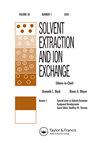季胺离子交换膜从发菜中分离藻胆蛋白
IF 2.1
4区 化学
Q3 CHEMISTRY, MULTIDISCIPLINARY
引用次数: 0
摘要
藻胆蛋白(PB)是由蓝藻产生的一种具有潜在应用价值的药物。在本研究中,通过使用含有季氨基的非织造织物膜(Rx-1)来分离PB。PB是通过冷冻-解冻方法破坏细胞壁从发藻群落中提取的,发藻群落是一种微藻。通过凝胶渗透色谱法鉴定了两种类型的生物分子,即PB和其他生物分子X。含PB的溶液通过Rx-1的渗透使滤液中PB的纯度从0.25增加到0.45。通过将实验数据拟合到数学模型来确定每种蛋白质在Rx-1上的吸附常数(Kp)和最大吸附量(qmax)。所获得的K p和q max的值用于模拟含PB溶液的放大处理。含PB溶液的渗透性(3.0 1.2时的L × 10−3 m3/h)通过Rx-1(放大膜的体积,8.0 × 10−4 m3)使PB分离26 h.可以通过使用Rx-1膜与硫酸铵溶液和超滤膜的沉淀相结合来实现PB的进一步纯化。本文章由计算机程序翻译,如有差异,请以英文原文为准。
Separation of Phycobiliprotein from Nostoc Commune by Using Ion-Exchange Membrane with Quaternary Amine
ABSTRACT Phycobiliprotein (PB), which is produced by cyanobacteria, has potential applications as a valuable pharmaceutical product. In this study, PB was separated by using a nonwoven-fabric membrane (Rx-1) that contained quaternary amino groups. PB was extracted from a Nostoc commune, which is a type of microalga, by disrupting the cell walls by a freeze–thaw method. Two types of biomolecules, namely PB and other biomolecules X, were identified by gel permeation chromatography. Permeation of the PB-containing solution through Rx-1 increased the purity of the PB in the filtrate from 0.25 to 0.45. The adsorption constant (K p) and maximum adsorbed amount of each protein on Rx-1 (q max) were determined by fitting the experimental data to a mathematical model. The obtained values for K p and q max were used to simulate scaled-up treatment of a PB-containing solution. Permeation of a PB-containing solution (3.0 L at 1.2 × 10−3 m3/h) through Rx-1 (volume of scale-up membrane, 8.0 × 10−4 m3) enabled PB separation for 26 h. Further PB purification could be achieved by using the Rx-1 membrane in combination with precipitation with ammonium sulfate solution and an ultrafiltration membrane.
求助全文
通过发布文献求助,成功后即可免费获取论文全文。
去求助
来源期刊
CiteScore
4.40
自引率
5.00%
发文量
15
审稿时长
8.4 months
期刊介绍:
Solvent Extraction and Ion Exchange is an international journal that publishes original research papers, reviews, and notes that address all aspects of solvent extraction, ion exchange, and closely related methods involving, for example, liquid membranes, extraction chromatography, supercritical fluids, ionic liquids, microfluidics, and adsorption. We welcome submissions that look at: The underlying principles in solvent extraction and ion exchange; Solvent extraction and ion exchange process development; New materials or reagents, their syntheses and properties; Computational methods of molecular design and simulation; Advances in equipment, fluid dynamics, and engineering; Interfacial phenomena, kinetics, and coalescence; Spectroscopic and diffraction analysis of structure and dynamics; Host-guest chemistry, ion receptors, and molecular recognition.

 求助内容:
求助内容: 应助结果提醒方式:
应助结果提醒方式:


